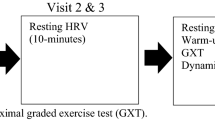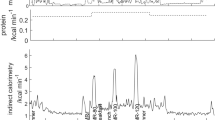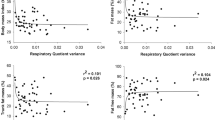Abstract
Objective:
This study examines the impact of a short-term exercise programme, prescribed on the basis of current exercise recommendations, on energy balance in males and females to assess whether this type of exercise induces compensatory changes in spontaneous activity energy expenditure (SAEE) and energy intake (EI).
Design:
Individuals were monitored for 16 days, 8 days of habitual physical activity (C) and 8 days when exercise was imposed (E). Total energy expenditure (TEE) was calculated from individual relationships of V̇O2 and V̇CO2 to heart rate (HR) records of HR and physical activity obtained during waking hours of the C and E periods and basal metabolic rate (BMR) measurements (Deltatrac System, Datex Instrumentation). Changes in nude body mass (BM) were estimated by using a digital scale (Sartorius AG, Gottigen, Germany).
Setting:
Laboratory and free-living.
Subjects:
Eight lean females (body fat: 17.5±4.5%) and eight males of similar percentage body fat participated in this study. All subjects were Caucasian and aged between 20 and 25 years.
Intervention:
During the E period, a supervised exercise session was conducted every second day, each consisting of a total net energy expenditure of 2092 kJ+BMR at 90% lactate threshold.
Results:
During the E period, TEE was higher than C in males and females (exercise: 95.2±13.9, 78.3±15.9 MJ; control: 82.4±10.4, 68.8±16.7 MJ, respectively; P<0.00; P=0.02). SAEE, calculated as TEE minus the energy expended during exercise, was not significantly different between C (males: 82.4±4.8 MJ; females: 68.8±7.6 MJ) and E (males: 86.8±6.3 MJ; females: 70.0±7.2 MJ) periods in either gender. Males showed no change in BM over the C (pre-intervention: 83.4±7.2 kg; post-intervention: 83.1±6.8 kg) or E (pre-intervention: 83.4±6.8 kg; post-intervention: 83.4±6.8 kg) periods. Females’ BM over the C period did not alter (pre-intervention: 63.3±2.8 kg; post-intervention 63.7±3.1 kg); however, there was a significant decrease (P<0.00) in BM over the E period (pre-intervention: 63.0±2.7 kg; post-intervention: 62.4±2.7 kg).
Conclusion:
The exercise programme was achieved in males and females without any impact on SAEE. Therefore, differences between genders in relation to BM reduction can be explained by differences in the EI response to exercise.
This is a preview of subscription content, access via your institution
Access options
Subscribe to this journal
Receive 12 print issues and online access
$259.00 per year
only $21.58 per issue
Buy this article
- Purchase on Springer Link
- Instant access to full article PDF
Prices may be subject to local taxes which are calculated during checkout

Similar content being viewed by others
References
Andersson B, Xu XF, Rebuffe-Scrive M, Terning K, Krotkiewski M, Bjorntorp P (1991). The effects of exercise training on body composition and metabolism in men and women. Int J Obes Relat Metab Disord 15, 75–81.
Beaver WL, Wasserman K, Whipp BJ (1985). Improved detection of lactate threshold during exercise using log transformation. J Appl Physiol 60, 1936–1940.
Bouchard C, Despres JP, Tremblay A (1993). Exercise and obesity. Obes Res 73, 133–147.
Despres JP, Bouchard C, Savard R, Tremblay A, Marcotte M, Theriault G (1984). The effect of a 20-week endurance training program on adipose-tissue morphology and lipolysis in men and women. Metabolism 33, 235–239.
DoH (UK Department of Health) (1991). Dietary reference values for food energy and nutrients in the United Kingdom. Report on Health and Social Subjects No. 41. Report of the panel on dietary reference values of the committee on medical aspects of food policy. HMSO: London.
Durnin JVGA, Womersley J (1974). Body fat assessed from total body density and its estimation from skinfold thickness: measurements on 481 men and women aged from 16 to 72 years. Br J Nutr 32, 77–97.
Forbes GF, Brown MR, Welle SL, Lipindski BA (1986). Deliberate overfeeding in females and males: energy cost and composition of the weight gain. Br J Nutr 56, 1–9.
Gibney ER (2001). The physical, psychological and metabolic effects of nutritional depletion and subsequent repletion. PhD Thesis, University of Cambridge, Cambridge, UK.
Goldberg GR, Prentice AM, Davies HL, Murgatroyd PR (1988). Overnight and basal metabolic rates in men and women. Eur J Clin Nutr 42, 137–144.
Goran MI, Poehlman ET (1992). Endurance training does not enhance total energy expenditure in healthy elderly persons. Am J Physiol 263, E950–E957.
Gwinup G (1975). Effect of exercise alone on the weight of obese women. Arch Intern Med 135, 676–680.
Imbeault P, Saint-Pierre S, Almeras N, Tremblay A (1997). Acute effects of exercise on energy intake and feeding behaviour. Br J Nutr 77, 511–521.
Janssen GME, Graef CJJ, Saris WHM (1989). Food intake and body composition in novice athletes during a training period to run a marathon. Int J Sports Med 10, S17–S21.
Johnstone AM (2001). Weight loss in human obesity. PhD Thesis, University of Aberdeen, Aberdeen, UK.
Jones AM (1998). A five year physiological case study of an Olympic runner. Br J Sports Med 32, 39–43.
Kempen KP, Saris WH, Westerterp KR (1995). Energy balance during an 8-wk energy restricted diet with and without exercise in obese women. Am J Clin Nutr 62, 722–729.
King NA, Blundell JE (1995). High fat foods overcome the energy expenditure due to exercise after cycling and running. Eur J Clin Nutr 49, 114–123.
King NA, Burley VJ, Blundell JE (1994). Exercise induced suppression of appetite: effects on food intake and implications for energy balance. Eur J Clin Nutr 48, 715–724.
King NA, Lluch A, Stubbs RJ, Blundell JE (1997). High dose exercise does not increase hunger or energy intake in free living males. Eur J Clin Nutr 51, 478–483.
King NA, Snell L, Smith RD, Blundell JE (1996). Effects of short-term exercise on appetite response in unrestrained females. Eur J Clin Nutr 50, 663–667.
Kissileff HR, Pi-Suyner XF, Segal K, Meltzer S, Foelsch PA (1990). Acute effects of exercise on food intake in obese and non-obese women. Am J Clin Nutr 52, 240–245.
Kramer FM, Jeffery RW, Forster JL, Snell MK (1989). Long-term follow up of behavioural treatment for obesity: patterns of weight regain among men and women. Int J Obes Relat Metab Disord 13, 123–136.
Lluch A, King NA, Blundell JE (1998). Exercise in dietary restrained women: no effect on energy intake but change in hedonic ratings. Eur J Clin Nutr 52, 300–307.
Melzer K, Kayser B, Saris Wim HM, Pitchard C (2005). Effects of physical activity on food intake. Clin Nutr 24, 885–895.
Miller WC (1999). How effective are traditional dietary and exercise interventions for weight loss? Med Sci Sports Exerc 31, 1129–1134.
Mitchell JB, Grandjean PW, Pizza FX, Starling RD, Holtz RW (1994). The effect of volume ingested on rehydration and gastric emptying following exercise-induced dehydration. Med Sci Sports Exerc 26, 1135–1143.
Mohamed-Ali V, Pinkey JH, Coppack SW (1998). Adispose tissue as an endocrine and paracrine organ. Int J Obes 22, 1145–1158.
Moon JK, Butte NF (1996). Combined heart rate and activity improve estimates of oxygen consumption and carbon dioxide production rates. J Appl Phys 81, 1754–1760.
NIH Consensus Development Panel on Physical Activity and Cardiovascular Health (1996). Physical activity and cardiovascular health. JAMA 276, 241–246.
Peters JC, Wyatt HR, Donahoo WT, Hill JO (2002). From instinct to intellect: the challenge of maintaining healthy weight in the modern world. Obes Rev 3, 69–74.
Pi-Suyner FX (1993). Medical hazards of obesity. Ann Intern Med 119, 655–660.
Pols MA, Peeters PH, Bueno-De-Mesquita HB, Ocke MC, Wentink CA, Kemper HC et al. (1995). Validity and repeatability of a modified Baecke questionnaire on physical activity. Int J Epidemiol 24, 381–388.
Reger WE, Allison TA, Kurucz RL (1984). Exercise, post exercise metabolic rate and appetite. Sport Health Nutr 2, 115–123.
Saris WHM, Blair SN, van Baak MA, Eaton SB, Davies PSW, Di Pietro L et al. (2003). How much physical activity is enough to prevent unhealthy weight gain? Outcome of the IASO 1st Stock Conference and consensus statement. Obes Rev 4, 101–114.
Segal KR, Pi-Suyner FX (1989). Exercise and obesity. Med Clin North Am 73, 217–236.
Slentz CA, Duscha BD, Johnson JL, Ketchum K, Aiken LB, Samsa GP et al. (2004). Effects of the amount of exercise on body weight, body composition and measures of central obesity. Arch Intern Med 164, 31–39.
Solomon SJ, Kurzer MS, Calloway DH (1982). Menstrual cycle and basal metabolic rate in women. Am J Clin Nutr 36, 611–616.
Staten MA (1991). The effect of exercise on food intake in men and women. Am J Clin Nutr 53, 27–31.
Stubbs RJ, Hughes DA, Johnstone AM, Hogan GW, King N, Blundell J (2002a). The effect of graded levels of exercise on energy intake and balance in free-living men, consuming their normal diet. Eur J Clin Nutr 56, 129–140.
Stubbs RJ, Sepp A, Hughes DA, Johnstone AM, King NA, Horgan G et al. (2002b). The effect of graded levels of exercise on energy intake in free living women. Int J Obes Relat Metab Disord 26, 866–869.
Sturm R, Wells KB (2001). Does obesity contribute as much to mortality as poverty or smoking? Public Health 115, 229–235.
Thompson DA, Wolfe LA, Eikelboom R (1988). Acute effects of exercise intensity on appetite in young men. Med Sci Sports Exercise 22, 222–227.
Trabulsi J, Schoeller DA (2001). Evaluation of dietary assessment instruments against doubly labeled water, a biomarker of habitual energy intake. Am J Physiol 281, E891–E899.
Tremblay A, Despres J, Leblanc C, Bouchard C (1984). Sex dimorphism in fat loss in response to exercise training. J Obes Weight Reg 3, 193–203.
Weir JB (1949). New methods for calculating metabolic rate, with special reference to protein metabolism. J Physiol 109, 1–9.
Westerterp KR, Meijer GAL, Janssen EME, Saris WHM, ten Hoor F (1992). Long term effect of physical activity on energy balance and body composition. Br J Nutr 68, 21–30.
Westerterp-Plantenga MA, Verwegen CRT, Ijedema MJW, Wijckmans NEG, Saris WHM (1997). Acute effects of exercise or sauna on appetite in obese and non-obese men. Physiol Behav 62, 1345–1354.
Wolf AM, Colditz GA (1998). Current estimates of the economic costs of obesity in the United States. Obes Res 6, 97–106.
Author information
Authors and Affiliations
Corresponding author
Additional information
Guarantor: MA Nimmo.
Contributors: RM carried out sample collection and data analysis and wrote the first draft of the manuscript. MN and DL assisted and provided advice during all stages of the work.
Rights and permissions
About this article
Cite this article
McLaughlin, R., Malkova, D. & Nimmo, M. Spontaneous activity responses to exercise in males and females. Eur J Clin Nutr 60, 1055–1061 (2006). https://doi.org/10.1038/sj.ejcn.1602417
Received:
Revised:
Accepted:
Published:
Issue Date:
DOI: https://doi.org/10.1038/sj.ejcn.1602417
Keywords
This article is cited by
-
Exploring activity compensation amongst youth and adults: a systematic review
International Journal of Behavioral Nutrition and Physical Activity (2022)
-
Effect of Exercise Training on Non-Exercise Physical Activity: A Systematic Review and Meta-Analysis of Randomized Controlled Trials
Sports Medicine (2017)
-
The ActivityStat Hypothesis
Sports Medicine (2013)



